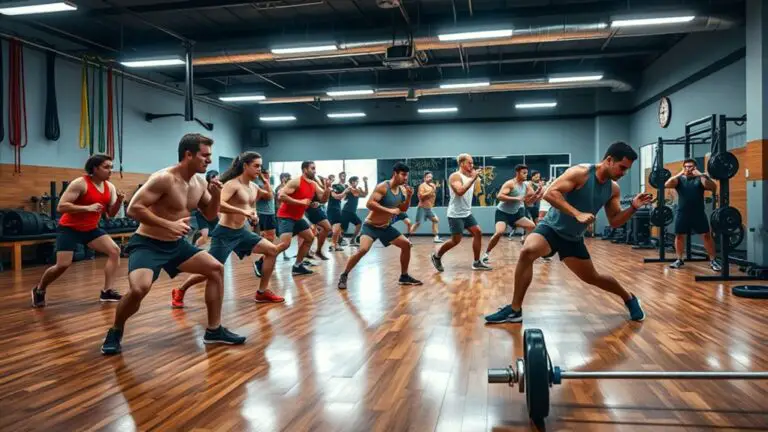How to Prevent Common Gym Injuries

To prevent common gym injuries, listen to your body and respect its limits. Always warm up properly to enhance flexibility and performance, and focus on using correct form to avoid strain. Gradually increase workout intensity to promote safe adaptation, and don’t forget to incorporate rest and recovery days. Stay nourished with balanced meals, and hydrate well. Pay attention to any discomfort or pain, as early detection is key. Keep going, and you’ll discover more helpful strategies to stay injury-free.
Understand Your Body and Its Limits

When you’re hitting the gym, it’s important to recognize that understanding your body and its limits is the foundation of a safe and effective workout. Developing body awareness allows you to listen to what your body is telling you, helping you avoid injuries. Pay attention to how your muscles feel during exercises; if something feels off, don’t push through the pain. Instead, adjust your approach or take a break.
Knowing your physical limits is just as vital. Everyone’s strength and endurance levels are different, and trying to lift weights or perform exercises beyond your capability can lead to serious injuries. Start with manageable weights and gradually increase them as you build confidence and strength. This approach not only maximizes your performance but also enhances your overall gym experience. By respecting your body’s signals, you’ll create a sustainable workout routine that keeps you healthy and motivated.
Warm Up Properly Before Workouts
Before you hit the gym, warming up is essential to prevent injuries and enhance your performance. Incorporating dynamic stretching techniques can increase your flexibility and prepare your muscles for action, while gradually increasing the intensity of your workout guarantees your body adapts safely. Remember, a proper warm-up not only protects you but also sets the tone for an effective session ahead.
Dynamic Stretching Techniques
Dynamic stretching techniques are essential for warming up properly before hitting the gym, as they prepare your muscles and joints for the demands of your workout. Incorporating dynamic warm-ups into your routine not only enhances flexibility training but also reduces the risk of injuries. Here are some effective techniques to take into account:
- Leg swings to open up your hip flexors
- Arm circles to loosen shoulder joints
- High knees to elevate heart rate and engage your core
- Walking lunges to stretch and strengthen your legs
- Torso twists to improve spinal mobility
Gradual Intensity Increase
To effectively prepare your body for a workout, it’s crucial to gradually increase the intensity of your exercises. Start with a warm-up that includes light movements, allowing your muscles to adapt. Think of this as a way to apply progressive overload; you’re setting the stage for your body to handle more challenging workouts. As you progress, make incremental adjustments, whether it’s increasing weights, reps, or intensity. This method not only helps prevent injuries but also enhances your performance over time. Remember, pushing too hard too soon can lead to setbacks. Listen to your body, and let it guide your pace. By incorporating these principles, you’ll cultivate strength while minimizing injury risk. Your future self will thank you!
Use Correct Form and Technique

Using correct form and technique is vital for maximizing your workout and preventing injuries. By understanding exercise mechanics, engaging your core muscles, and focusing on your breathing, you’ll not only enhance your performance but also keep your body safe. Remember, a strong foundation in these areas sets you up for long-term success in the gym. Additionally, being mindful of proper technique can help reduce the risk of knee injuries while exercising.
Understand Exercise Mechanics
Although it might seem tempting to lift heavier weights or push through more reps, mastering exercise mechanics and using correct form is essential for preventing injuries. Understanding exercise biomechanics and performing a thorough movement analysis can help you identify the right techniques for your workouts. Here are some key points to keep in mind:
- Maintain a neutral spine to reduce strain on your back.
- Align your knees with your toes to prevent joint injuries.
- Engage your muscles properly throughout each movement.
- Control your speed to enhance stability and precision.
- Focus on your breathing to support overall performance.
Engage Core Muscles
Mastering exercise mechanics lays a strong foundation for injury prevention, but engaging your core muscles takes your workouts to the next level. Core stability is essential for maintaining proper form and technique during any exercise. When you actively engage your core, you create a solid base that enhances your balance and coordination. This not only helps you lift heavier weights but also minimizes the risk of injuries caused by improper posture or muscle strain.
To effectively engage your core, focus on tightening your abdominal muscles and maintaining that tension throughout each movement. Remember, it’s not just about working out; it’s about doing it smartly. Prioritize core engagement, and you’ll notice improved performance and reduced injury risk, setting you up for long-term success in the gym.
Focus on Breathing Techniques
While you might be focused on lifting weights or completing sets, don’t underestimate the power of proper breathing techniques in your workouts. Mastering your breathing patterns can enhance performance and reduce injury risk. Here’s how diaphragmatic breathing can help:
- Stabilizes your core: A strong core supports proper form.
- Increases oxygen flow: More oxygen means better endurance.
- Reduces stress: Controlled breathing calms your mind, improving focus.
- Enhances power: Coordinated breaths boost lifting capacity.
- Improves recovery: Proper breathing aids in muscle recovery post-workout.
Gradually Increase Workout Intensity

As you begin your fitness journey, it’s crucial to remember that gradually increasing workout intensity is key to preventing injuries. Utilizing the principle of progressive overload helps your body adapt safely to new challenges. Start by setting clear intensity benchmarks—these can be based on time, weight, or repetitions.
Instead of jumping into high-intensity workouts, increase your intensity incrementally. For instance, if you’re lifting weights, add a small amount each week, or if you’re running, gradually extend your distance or speed. Listen to your body; if you feel pain or excessive fatigue, it’s a sign to slow down. Acknowledging the need for rest days is essential to avoid burnout and support recovery.
Incorporating this gradual approach not only boosts your strength and endurance, but it also minimizes the risk of injury, allowing you to enjoy your fitness journey without setbacks. Remember, consistency is more important than intensity in the beginning. Stay committed, and you’ll see progress!
Incorporate Rest and Recovery Days
After you’ve established a routine of gradually increasing your workout intensity, it’s important to prioritize rest and recovery days. These days aren’t just about doing nothing; they’re essential for your body to repair and strengthen. By incorporating scheduled rest and active recovery, you can enhance your performance and prevent injuries.
Prioritizing rest and active recovery is vital for muscle repair and enhancing performance.
Consider these key points for effective recovery:
- Listen to your body: Pay attention to signs of fatigue or discomfort.
- Plan active recovery: Engage in low-impact activities like walking or yoga.
- Prioritize sleep: Quality rest is crucial for muscle repair.
- Incorporate stretching: This aids flexibility and reduces risk of injury.
- Stay consistent: Make recovery a regular part of your routine, not just an afterthought.
Stay Hydrated and Nourished

Proper hydration and nutrition play an essential role in preventing gym injuries, as they fuel your body and aid in recovery. Understanding hydration importance isn’t just about drinking water; it’s about maintaining electrolyte balance to support muscle function. Dehydration can lead to cramps and fatigue, increasing your injury risk. Always keep a water bottle handy and sip throughout your workout.
Nutrition timing is equally important. Consuming the right nutrients before and after your workouts can enhance your performance and recovery. Aim for a balanced meal rich in carbohydrates and protein about 30 to 60 minutes before exercising. Post-workout, refuel with a protein-rich snack to help repair muscles and replenish energy stores. Additionally, understanding your daily protein needs is crucial for optimizing muscle recovery.
Listen to Your Body and Address Pain Immediately
Listening to your body is essential in preventing gym injuries, especially when you feel any discomfort or pain during your workout. Ignoring pain signals can lead to serious injuries, so it’s crucial to develop strong body awareness. Here’s how to address pain immediately:
- Recognize Pain: Don’t dismiss it as fatigue; it’s your body’s way of communicating.
- Assess the Situation: Determine if it’s a minor ache or a warning sign of something more severe.
- Modify Your Routine: Adjust your exercises or intensity to alleviate discomfort.
- Rest and Recover: Give yourself time to heal; pushing through can worsen the injury.
- Seek Professional Help: Consult a trainer or physical therapist if pain persists. Additionally, understanding proper warm-up techniques can significantly reduce the risk of injuries during workouts.
Frequently Asked Questions
What Should I Do if I Experience Pain During a Workout?
When you feel pain during a workout, it’s like a red flag waving in the wind, urging you to pause. First, listen to your body; don’t push through discomfort. Implement pain management strategies, like rest or ice, and consider workout modifications to avoid exacerbating the issue. Focus on gentle movements or alternative exercises that maintain your fitness while allowing healing. Remember, it’s better to take a step back than risk a more serious injury.
How Often Should I Change My Workout Routine to Prevent Injuries?
Changing your workout routine every 4 to 6 weeks can help keep your body challenged and prevent overuse injuries. Incorporating workout variety not only keeps things interesting but also targets different muscle groups, enhancing your overall fitness. Sticking to the same routine for too long can lead to plateaus and increase injury risk. So, mix it up, listen to your body, and stay motivated on your fitness journey!
Are Certain Gym Machines Safer Than Others for Beginners?
You’d think every gym machine is a ticket to fitness glory, right? Ironically, some can be traps for beginners. When selecting machines, prioritize those with clear instructions and adjustable settings. Leg presses and cable machines often offer more control, making them safer choices. Remember, mastering form is key, so take your time and don’t hesitate to ask for help. With these beginner tips, you’ll navigate the gym like a pro in no time!
Can I Prevent Injuries by Using Supplements or Vitamins?
You might wonder if you can prevent injuries through supplements or vitamins. While they can offer supplement benefits, they’re not a magic bullet. Your body needs essential nutrients to function effectively, and vitamin deficiencies can lead to weakness or fatigue, increasing injury risk. A balanced diet is vital, but if you’re lacking specific nutrients, targeted supplements can support your training. Just remember, they should complement, not replace, a healthy lifestyle.
What Role Does Mental Focus Play in Injury Prevention?
You wouldn’t believe it, but your mind can be the ultimate superhero in injury prevention! Mental readiness is essential; if you’re distracted or unfocused, you’re practically inviting injuries to crash your workout party. By employing focus techniques like visualization or mindfulness, you sharpen your awareness and enhance coordination. So, when you hit the gym, channel that mental power—it’s your secret weapon against mishaps and a key part of staying strong and injury-free!





